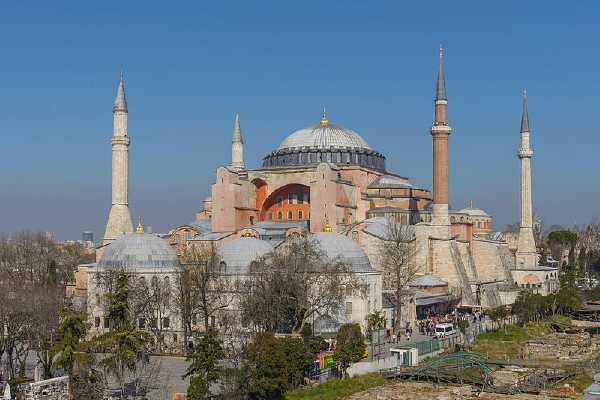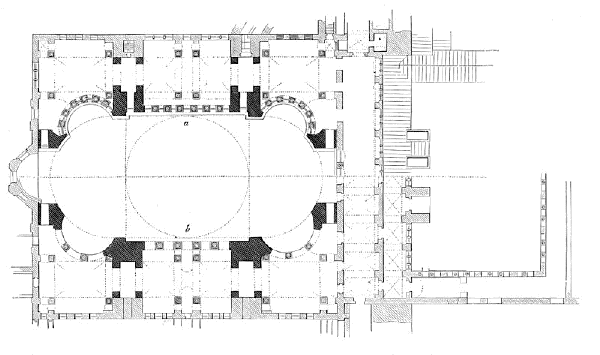| Hagia
Sophia ["Holy
Wisdom"] a Byzantine church/mosque/museum in
Istanbul, Turkey
The first church on this site was known as the
Megále Ekklesía, "Great
Church," which was dedicated in 360. It and
the nearby Hagia Eirene ("Holy
Peace:) served as the principal churches of the
Byzantine Empire until 404, when the Great Church
was burned to the ground during a series of riots
spurred by the exile of the Patriarch of
Constantinople John Chrysostom. Nothing of the
first church exists today.
A second church was ordered by Theodosius II,
who dedicated it in 415. This church, the first
to be called Hagia Sophia, stood until
532, when it was destroyed by fire during the
Nika Revolt. Several marble blocks from the this
church survive to the present, including reliefs
depicting 12 lambs representing the 12 apostles.
A few weeks after the destruction of the
second church, Emperor Justinian the Great,
against whom the Nika Revolt had been directed,
ordered construction of an even greater church on
the site. Built under the direction of Isidore of
Miletus and Anthemius of Thales, the structure
that stands today was completed in 537. Although
the dome had to be repaired several times over
the next half century, the church stood solidly
as the seat of the Orthodox Patriarch of
Constaninople for 900 years, even surviving an
attack by Crusaders in 1204.

In 1453, Sultan Mehmet the Conqueror captured
the city and converted Hagia Sophia into a
mosque. Aside from the addition of minarets and
the shoring up of the dome and vaults, no
architectural changes were made to the structure.
The rich interior mosaics were painted over,
however, and many of the interior elements were
adapted to suit Islamic purposes.
In 1935, the government of Mustafa Kemal
Ataturk secularized Hagia Sophia and turned it
into the Ayasofa Museum. Since then, many of the
mosaics and tile floors have been restored and
structural repairs have been made.
The main building is 246 feet from east to
west and 230 feet north to south. The central
nave is covered by a dome that is 102 feet across
and 185 feet high. At the western and eastern
ends, the arched openings are extended by
semi-domes. The flat wall on each side of the
interior (north and south) is called a tympanum,
and each one has 12 large windows in two rows,
seven in the lower and five in the upper. All
interior surfaces are sheathed with polychrome
marble, green and white with purple porphyry, and
gold mosaics Just outside the entrance, stone
cannonballs used by Mehmet the Conqueror line the
gravel path of the outer courtyard. There are
several interesting things to see outside Hagia
Sophia, including three mausoleums of sultans,
the church's baptistery, and the excavated
remains of Theodosius' Hagia Sophia.


Hagia Sophia http://www.hagiasophia.com/
Metropolitan Museum of Art http://www.metmuseum.org/toah/hd/haso/hd_haso.htm
Sacred Destinations http://www.sacred-destinations.com/turkey/istanbul-hagia-sophia
Questions or comments about
this page?
|



